What if I told you that you could directly store information for someone else from your neighbourhood, region or even the other side of the world, with some spare space on a hard drive?
It seems bizarre, but hold that thought. Technological disruptors are nothing new, particularly over the past 10-15 years. Various companies across a broad range of sectors have harnessed the potential of underutilised resources to provide more options to the general public at competitive prices.
Uber kick-starting the rideshare revolution; Airbnb with accommodation; Amazon, eBay and others with online marketplaces…the list goes on.
Back to data storage. No exorbitantly-priced and enormous machinery, no centralised provider, and anyone willing to contribute to the network in the process (more on this shortly) can benefit from this innovation.
Thanks to protocols such as Filecoin, this is a reality and is gradually preparing itself to go mainstream, like several other amazing projects in the crypto space.
Let’s dive deeper into this project.
What is Filecoin, and how does it work?
It aims to overhaul the current system of large volumes of data often archived on centralised cloud servers, dominated by tech giants such as Amazon, Microsoft, IBM and Google (Alphabet).
Rather than going through these established players, it allows more participants to offer data storage on an open marketplace, displaying available storage capacity and rates.
By permitting this open participation for many more suitable storage providers, particularly small-scale operators, this vastly increased supply relative to demand leads to ultra-competitive pricing versus the established setup of corporate players in this space.
Data-storage suppliers compete with each other to provide the most competitive prices for clients. As a result, when (not if) this decentralised setup becomes mainstream, this should force AWS, Microsoft Azure and others to lower their prices without compromising any benefits for their customers.
For context, Amazon Web Services (AWS) and Microsoft Azure, the world’s largest cloud service providers, account for more than $110 billion (in revenue, combined, above $50 billion, each). In relative terms, they represent the majority (52 to 55%) of the market share in this space.
How can we ensure that the supplier always holds the data? This is verified through cryptographic proofs (see ‘FIL mining’), whereby these providers send storage proofs in new blocks to the Filecoin network. Additionally, they are required to validate new blocks.
I will refrain from introducing complex and lengthy explanations; this summary (with corresponding figures) directly from Filecoin provides an excellent synopsis of what this entails.
Once clients want to retrieve a file, they seek an eligible storage provider to access it; customers can pick a preferred option, prioritising either speed or cost. After paying the successful bidder in FIL (required for all transactions in the Filecoin ecosystem), they can obtain the requested file(s).
Filecoin Virtual Machine
The FVM is the core cloud-based, decentralised computer that runs smart contracts on Filecoin’s network. One of its promising features is its compatibility with the Ethereum Virtual Machine (EVM), thus allowing new ERC-20 (Ethereum-compatible) tokens — both fungible and non-fungible (NFT) options — to utilise its storage solutions.
Last month, the team beyond the Filecoin blog announced the successful launch of the FVM on the ecosystem’s mainnet, including six important Ethereum-compatible aspects of the FVM. This opens up enormous opportunities for seamless interaction between Filecoin, Ethereum and the projects built on the latter’s blockchain.
“We’re thrilled to integrate with FVM and leverage its powerful smart contract capabilities to enhance the user experience on Sushiswap. With FVM, we can unlock new frontiers for decentralized finance and offer our users even more innovative and efficient solutions. We’re excited to continue collaborating with the Filecoin network and building the future of Web3 together.”
Jared Grey, CEO of Sushi
Moreover, smart contracts deployed on the FVM can also be written in Solidity, a programming language used for SCs on Ethereum’s blockchain.

Image by chanpipat on Shutterstock
Decentralised file storage and enhanced security
Besides the benefits of having a more inclusive and distributed file-storage infrastructure outlined above, there is another notable advantage of this setup, perhaps the most important one – security.
I am not implying that centralised servers cannot be trusted. Rather, a consistently reliable and distributed blockchain could benefit everyday users more than current options.
Provided that a protocol is adequately decentralised (many networks still have varying degrees of centralisation), is set up to avoid a 51% attack (i.e., majority control) of its chain, has abundant and well-distributed nodes around the world (for example, Bitcoin has over 47,500 nodes across 5,938 cities worldwide), this would be considered safer than centralised servers that have just one or very few points of failure.
FIL mining
Some of the nodes involved in running Filecoin involve FIL mining and can be divided into three broad categories:
– Storage miners: These connection points and devices are, at times, provided the opportunity to grow the Filecoin blockchain by creating their own (correct) blocks. These miners are subsequently gifted a new FIL and can earn new coins through transaction fees linked to other nodes.
As per the cryptographic proofs that I alluded to earlier, in which miners verify their guarantee that they’re securely storing the data, this is done through procedures involving Proof-of-Replication (PoRep) and Proof-of-Spacetime (PoSt); the latter has no connection to Proof-of-Stake (PoS). Furthermore, FIL is used as collateral to ensure miners fulfil their commitments.
Check out these pieces about sealing and Filecoin storage mining for more comprehensive info.
– Retrieval providers (miners) play an integral role in swiftly returning files to clients upon request, broadcasting data back and forth, off-chain. They receive FIL in return for this service.
– Repair miners, though these nodes have not yet been incorporated into the ecosystem. Their proposed role is to act as a backup in the event of malfunctioning storage miners.
Other nodes also have an integral role in Filecoin’s operations; I recommend this resource to discover more about the different types of nodes and their respective roles in the system.
For technical specs and a full run-down of FIL mining, there is this article from Cryptopolitan.
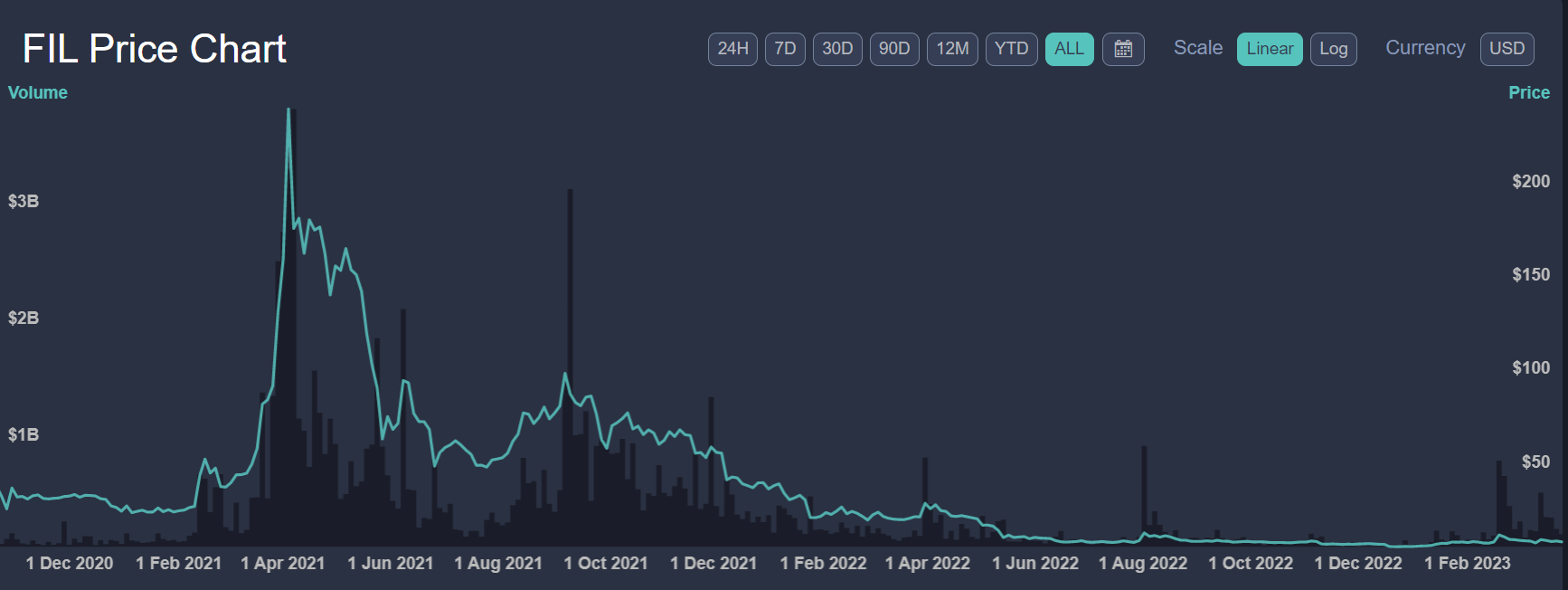
Source: LiveCoinWatch
News and partnerships
Decentralized Storage Alliance
Advanced Micro Devices (AMD), Seagate, and Ernst & Young (EY) have collaborated with Protocol Labs, the open-source R&D entity spearheading the Filecoin project, to form the Decentralized Storage Alliance.
In tandem with the not-for-profit Filecoin Foundation, the Alliance is working on assembling major firms and stakeholders in the Web2 and Web3 realms interested in promoting and adopting decentralised storage technologies.
Under this collab, they manage over 300 pebibytes (PiB) of hosted data, i.e., trillions of kilobytes, and more than 18 exbibytes (EiB) of network storage power (millions of gigabytes).
Whilst still early days for this venture, I foresee consistent growth in this sector in line with improvements to Filecoin and other distributed ledgers.
Special thanks to Brandy Betz at Coindesk for bringing this to my attention in this related article.
Extra-terrestrial file-sharing and Filecoin
Last May, the Filecoin Foundation (FF) publicised a partnership with Lockheed Martin for an apparatus to carry out the Interplanetary File System (IPFS) in space.
The IPFS is an open-source, peer-to-peer file-sharing scheme designed by Protocol Labs and Juan Benet, who also invented Filecoin.
The idea is to revolutionise data sharing in space by proposing a decentralised storage model to facilitate a more effective and faster transfer of information and general communication in space.
This is just one part of several ambitious and exciting projects for Filecoin, as revealed in the Foundation’s 2022 Annual Report, detailing what’s in store for this year.
I am pleased to announce that FF and Lockheed Martin will proceed with this project, launching the IFPS later this year on board the LM 400 Technology Demonstrator spacecraft.

Image by sdecoret on Shutterstock
Hedera and Filecoin
This relates to a previous post in July 2021 when the two covered details of an initial $200,000 investment in a grant program for improved Web3 interoperability.
“Hedera brings highly-efficient capabilities for NFT minting, issuance, and transfer, while Filecoin’s IPFS network offers a publicly accessible robust, flexible large-scale storage layer. Combining Hedera with Filecoin delivers a truly decentralized NFT experience for users of the HashAxis platform.”
—Hedera Team (HashAxis)
This $200K grant was available to developers for two sets of developments on Hedera Hashgraph and Filecoin’s blockchain:
– Decentralised Storage Software Development Kit (SDK) & Demo Application that involves minting NFTs on Hedera and storing the related multimedia on Filecoin, with prize money of $75,000 available to the most successful applicant.
– Real-world applications for proposed applications that utilise the Hedera Token Service and Filecoin’s decentralised storage. Prize money ranged from $5,000 to $50,000.
Whilst this refers to a grant program held in mid-2021, I am still mentioning this as I imagine similar schemes will be devised in future, as part of seeking and incentivising other talent to build on both Hedera and Filecoin.
FIL coin details and a new all-time high soon?
Whilst FIL is in the top 50 and thus out of reach for many seeking a 100x (or even a 1000x) gem, it is worth paying attention to how much lower it is from its all-time high of roughly $237.
Currently at ~$5 and with a market cap shy of $2 billion, it is down by ~97% from its ATH; a double-edged sword, depending on how you view it.
Whilst past performance does not guarantee future results, I predict massive potential with this altcoin, especially with the anticipated growth of the decentralised data-storage space in the coming years.
If I were to hazard a guess, I expect Filecoin to rapidly take off from late-2025/early-2026 as the protocol advances and service users grow considerably from where we are now. This timeframe will also coincide with the beginning of the mainstream adoption of crypto assets and distributed ledger technology.
As per FIL’s price, in the next 12-15 months or so, this would be driven more by market-wide hype (as is the case for many altcoins and tokens) than actual adoption, though I expect the latter to play some role in aiding the altcoin’s rise to(wards) its current all-time high.
Why do I think three years? In brief, the main factors for this are:
– Slow adoption of new ideas, especially in the first few years — Rideshare, accommodation, fintech, you name the sector. Companies and concepts take a while to get off the ground, at least organically. In reality, this could take more than three years for Filecoin to gain significant traction with network utility.
However, Bitcoin and Ethereum rose in popularity in less than ten years (the latter just a few years after launching).
– Trust — Decentralised (online) data storage is a nascent concept. In the early years, convincing enough people to migrate from or bypass well-established and (generally) trustworthy centralised cloud providers will be difficult. This is akin to those (young and old) that lack faith in cryptos such as BTC and ETH, self-custody of digital assets, etc., and instead, opt to keep vast sums of money in a traditional bank.
– Regulations — If established players were ever threatened, they would happily throw down the gauntlet, touch base with some influential government figures and express their disdain for this new idea aiming to disrupt their profitable business; it’s never fun to be kicked off the gravy train, let’s put it that way.
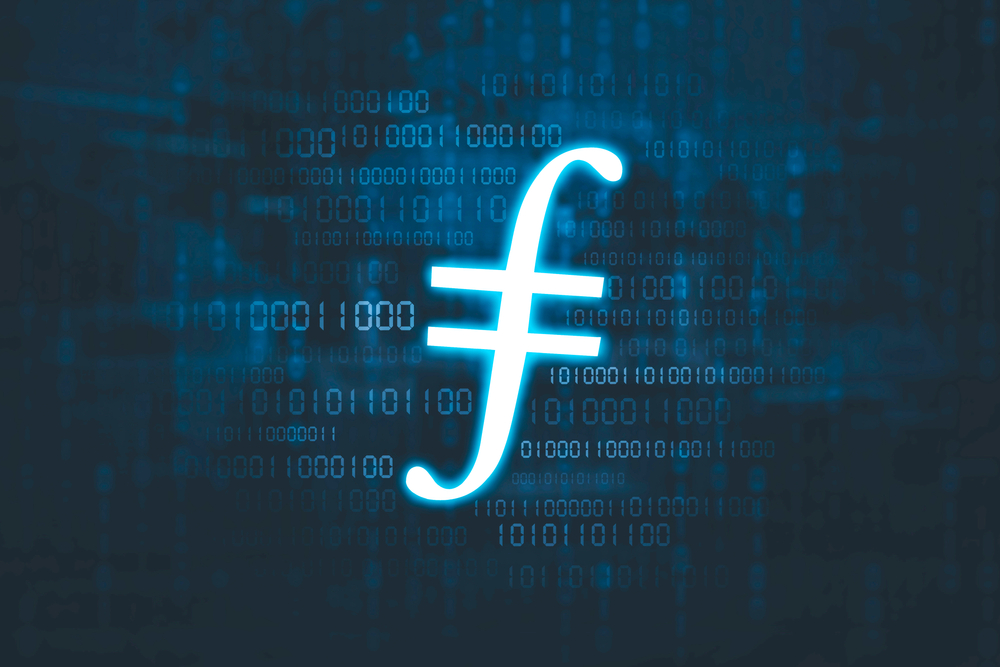
Image by Creativa Images on Shutterstock
We have seen how draconian multiple US regulators have been towards crypto assets and companies connected to this asset class/technology, so do not underestimate further punitive measures that could stifle innovation, briefly or otherwise.
Regarding the question above, when is soon in terms of a new ATH for FIL? No one knows, but the altcoin went from $36 to $237 in one month (1 March to 1 April 2021, the latter being its ATH date), which was partly influenced by bullish sentiment across the crypto space.
Thus, I believe it is highly plausible for FIL to eclipse $300 in the next bull cycle, when accounting for an improved network, more (expected) users, inflation, more liquidity across the crypto market vs 2021, (eventual) regulatory clarity in the USA surrounding altcoins, etc.
Filecoin Green
Rest assured, this is not some dubious, bogus spin-off of today’s project in focus, unlike what we’ve seen with Bitcoin over the years.
Rather, it is a real-time measure of energy metrics – predominantly sealing and data storage requirements –associated with Filecoin. This is an important measure to help it reduce its overall environmental impact from its electricity sources to the data storage hardware.
In regards to some charts included through their website (see below), it is positive to see continuous improvements in energy usage for both sealing and storing information (with major advancement for the former, see images below).
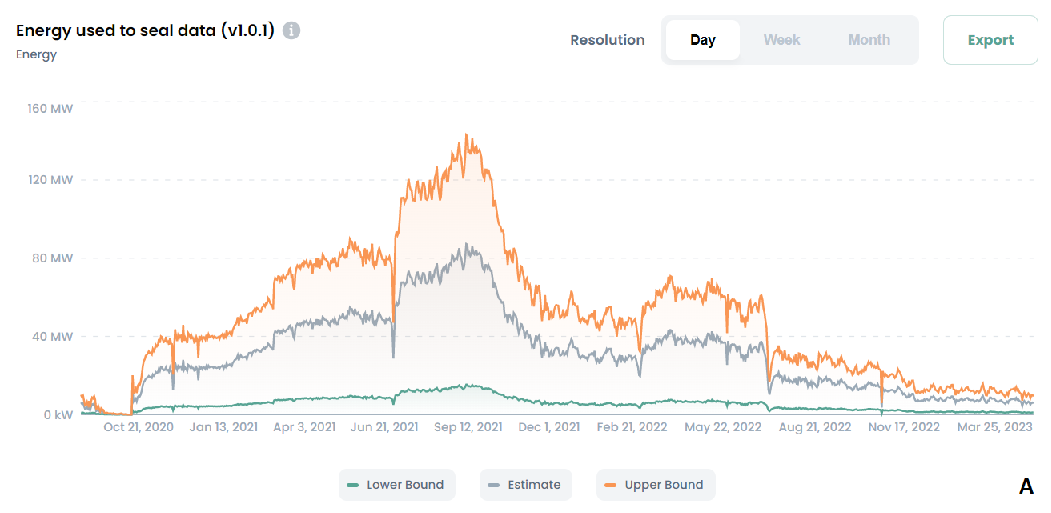
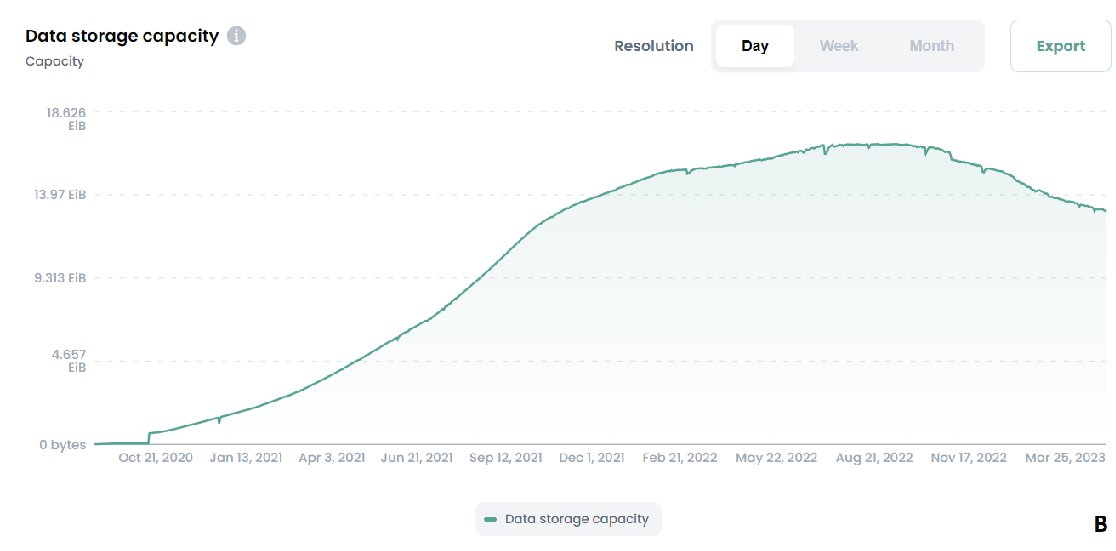
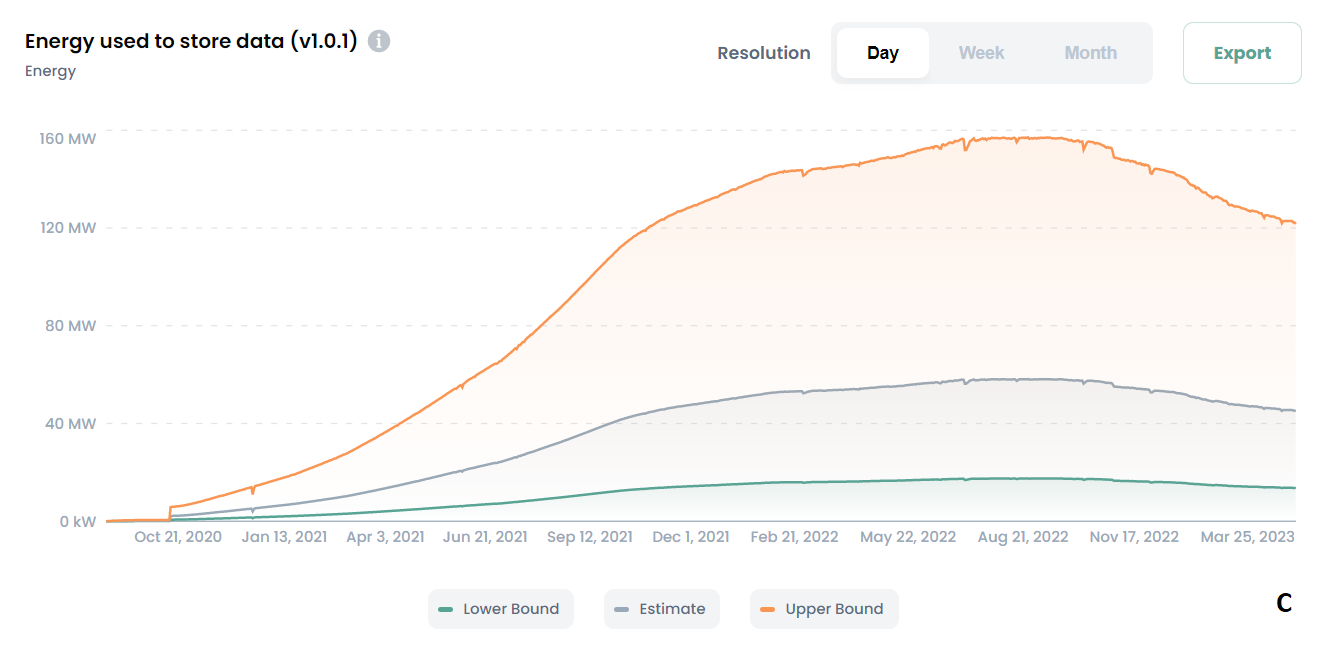 Despite a reduction in data storage capacity since its peak (to date) in August 2022 (Graph B), energy used to seal data has drastically improved since its maximum in September 2021 (Graph A). Nonetheless, much work must be done to substantially lower energy usage for data storage (Graph C). Source: Filecoin Green
Despite a reduction in data storage capacity since its peak (to date) in August 2022 (Graph B), energy used to seal data has drastically improved since its maximum in September 2021 (Graph A). Nonetheless, much work must be done to substantially lower energy usage for data storage (Graph C). Source: Filecoin Green
Before moving on, and without adding another figure or chart here, I want to point out that China alone accounts for over 45% of (recorded) storage providers listed through Filecoin Green, nearly 3x more than the USA (5,287 and 1,479, respectively).
I find this astonishing that there is such a strong concentration of these storage providers in just one nation. As a result, I expect the rest of the world, notably South Asia (India has only five providers, the same as Iceland…), South America and Europe to pick up their game and offer a lot more here to reduce* this abovementioned dominance.
*This has nothing to do with China specifically. If it were the USA or any other nation, I would still be worried about the figures, notably for a decentralised system or one striving for this.
Alan Ransil of Protocol Labs gives an excellent overview of Filecoin Green in this YouTube video.
Food for thought
With all crypto projects, competition is fierce, and whilst Filecoin is one of the dominant players in the decentralised data-storage realm, a rival could come along and offer a superior product; Sia (formerly Siacoin), Storj and other crypto protocols are working on similar projects.
Moreover, established and renowned tech behemoths could also create their in-house infrastructure that claims to be “decentralised” (even if it is partially the case) and find ways to retain existing clients relying on centralised cloud servers.
Hopefully, enough users recognise the importance of having a decentralised data storage and retrieval system that bypasses the reliance on centralised servers, though I am not holding my breath, at least not for the foreseeable future; I envisage that many will be initially sceptical, and still opt for the status quo, via Amazon, Microsoft, Google and others for the foreseeable future.
This will change once Filecoin (or a similar provider) becomes mainstream and enough people trust it to be a superior alternative; a matter of when not if.
The most promising aspect of Filecoin is allowing the average person to offer some spare HDD or SSD space to other individuals seeking storage through the protocol and make a (relatively) small yet continuous income stream by providing this service.
The concept of a decentralised, peer-to-peer (P2P) arrangement of bypassing an intermediary is also gaining traction in other parts of society, with microgrids and P2P energy trading revolutionising the sourcing and distribution of electricity, especially for small cities and communities; I made a corresponding piece about Energy Web and EWT regarding this phenomenon.
Additionally, once the system becomes popular, reliable and deemed trustworthy, this could expand to SMEs, and, perhaps, involve the big end of town.
I question how willing mega-corporations would be to migrate all (even the majority) of their company data from centralised databases to ones like Filecoin, though I could be wrong (and I hope I am); mind you, with the plethora of massive data breaches in recent years, the current setup for keeping sensitive data secure still leaves much to be desired.
Cloud storage is only expected to continue increasing several-fold when you factor in both hardware and software being able to handle greater volumes of data at significantly cheaper costs, the number of users continuing to increase year-on-year (YoY) as they gain access to the cloud, notably in developing countries.
There’s a lot to take in, but I hope this will help you appreciate what is in store for the future of cloud storage, whether it be through Filecoin or a rival project.
Ways to stay in the loop with Filecoin
– Official website
– Whitepaper
– Twitter (and a separate Filecoin developers page)
– Filecoin blog
– YouTube (mostly the technical aspects of Filecoin)
– Filecoin Foundation blog (different to the one listed above)
– Reddit
– Telegram
– Filecoin GitHub docs
– Discord
Please double-check the veracity of all these websites before interacting with anyone featured on these Filecoin/FIL pages and channels. I don’t use Reddit and Telegram, so I am going off what appear to be legitimate sources.
Additional resources
– In this four-chapter animated video, Filecoin’s explainer video provides one of the best summaries of what it is, storing data via the protocol, verifying storage, and how to retrieve files from the network;
– The network’s roadmap is another useful resource to help the community, and prospective FIL investors gauge what has been achieved so far and what is in the works, with tentative timelines for each objective.
Disclaimers
None of this is financial advice; I am not a financial advisor.
The opinions expressed within this piece are my own and might not reflect those behind Protocol Labs, Filecoin Foundation or any other organisation associated with Filecoin.
Please do sufficient research before investing in any crypto assets, staking, NFTs and other product affiliated with this space.
I hold a small amount of FIL, accounting for less than 1% of my total crypto portfolio.
If you enjoyed this article, I recommend following my Medium page for regular reports about crypto assets, blockchain technology, and more. Feel free to check out my publication as well, Crypto Insights AU.
Thanks for your support.
Featured image by Avi Rozen on Shutterstock.
<a href=”https://shop.ledger.com/pages/ledger-nano-s-plus/?r=a1b3ac23d773″><img width=728 height=90 src=”http://affiliate.ledger.com/image/728/90/Default”></a>


Hello cryptowithlorenzo.com admin, Thanks for the well-researched post!
Wоᴡ, awesome weblog format! How lengthy have you ever been running a blog fоr?
you make blogging look easy. Thе еntire look of your site is ɡreat, as ѕmartly as the content material!
Hi Frisian,
Thank you for the kind words and for reading. There are still many improvements to make to this website, but it is a decent start so far.
More content coming soon.
Regards,
Lorenzo